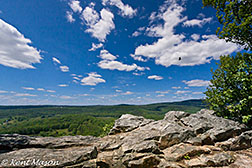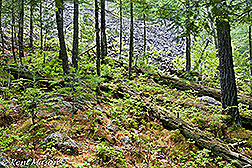- Number 387 |
- April 29, 2013
West Virginia’s Ice Mountain: Where science meets magic

Guided hikes on Ice Mountain are possible
by contacting volunteers for The Nature
Conservancy. One trail up the mountain
takes you to the ice vents, while a second
leads to the scenic overlook, a habitat for
ravens and bald eagles.
Photo courtesy of Kent Mason
On August 6, 1918, the thermometer hit 109 degrees in Hampshire County, West Virginia. It’s easy to believe that the sweltering residents of North River Mills considered walking to nearby Ice Mountain, where the air was sure to be 30 or 40 degrees cooler. It must have amazed newcomers that such a modest hill could be so cold. But that’s how it was, and that’s how it had always been, and that’s how the 1,376-foot-tall mountain got its name. The children living on the local farms likely knew about the phenomenon and called it magic. Their parents surely called it Providence. What no one would have called it then was an “algific talus slope.”
That’s what it’s called now by researchers like Dr. Hank Edenborn of DOE's National Energy Technology Laboratory, who study these huge natural refrigerators. Ice Mountain is actually a long ridge, running southwest to northeast, as do most of the ridges in the Allegheny Mountains. What makes it different from the other ridges that stripe West Virginia’s eastern panhandle is the tumbled-down collection of sandstone boulders, called talus, piled on its northwestern face. Algific simply means the boulder-strewn slope is cold-producing, but it doesn’t explain why. That’s left to scientists like Edenborn.
Naturally occurring cold sites exist worldwide and have mystified local residents for generations. “Not all of these sites are well understood, but we have a good handle on what happens on Ice Mountain,” explains Edenborn. “Cold air and water enter the talus during the winter and form ice. When the weather warms, cold air flows out of openings or ‘vents’ in the base of the talus, resulting in locally cold temperatures.” Ice is often visible between the boulders well into summer. A century ago, residents of North River Mills routinely celebrated the Fourth of July by collecting ice from the talus for ice cream and chilled lemonade. There are reports of ice lasting some years into September.
What the term “algific talus slope” also leaves undescribed are their unusual, seemingly misplaced ecosystems, which survive by a trick of nature. When noted climatologist Edwin S. Balch studied anomalous cold sites in temperate Europe and North America at the turn of the 20th century, he said about one such curiosity, “Although I am not much of a botanist, yet it seemed to me that the flora immediately near the talus was somewhat different in character from that of the surrounding country.”
Balch was right. Twinflower, Arctic rose, northern bedstraw, dwarf dogwood, and Canada mayflower—boreal plants with no business being this far south or at such a low elevation—all thrive in the microclimate on Ice Mountain. Look closely, and you may also spy the cherrystone drop, a tiny terrestrial snail that crawled over large portions of North America during the last glacial period, but is now only found in isolated regions of Appalachia and the upper Midwest. Also there, but mostly unseen, are a host of cold-loving algae, fungi, and bacteria. These are what brought Edenborn to study cold sites such as Ice Mountain.
Dr. Edenborn is the lone microbiologist at the National Energy Technology Laboratory, a U.S. Department of Energy national laboratory. One of his duties is to seek out novel microorganisms and investigate how they might be used by the energy industry. It’s well known, for example, that some microbes chomp on hydrocarbons and can be used, in a process called bioremediation, to help clean up contaminated sites. Could cold sites such as Ice Mountain hold the key to remediating petroleum contamination in cold climates?

Tumbled-down boulders, called talus, on
Ice Mountain’s north-western slope collect
ice during the winter. In the summer, cold
air flows out of vents in the base of the
talus, lowering temperatures.
Photo courtesy of Kent Mason
For several years now, Edenborn has collaborated with university researchers and other experts to characterize cold sites in the Alleghenies and answer this question. One recent paper, published in Permafrost and Periglacial Processes, describes a 3-year project in which Edenborn, an NETL colleague, and a professor at West Virginia University remotely collected hourly temperatures in and around the Trough Creek Ice Mine in central Pennsylvania. Another paper, Contributions to the lichen flora of Pennsylvania: Notes on the lichens of a remarkable talus slope in Huntingdon County, presents results from a botanical survey of the Spruce Creek Ice Caves conducted by Edenborn and his colleagues at the New York Botanical Garden. Included is a list of 66 lichens and associated fungi found in the ice caves, 15 of which were being reported for the first time in the Commonwealth of Pennsylvania.
While Edenborn hasn’t yet found the hoped-for oil-degrading, cold-loving wonderbug, his work has had another, unexpected benefit: helping to establish Ice Mountain Preserve as a National Natural Landmark.
In 1989, The Nature Conservancy purchased 159 acres on Ice Mountain, including the entire algific talus slope, in order to protect its rare and fragile ecosystem. Working with public and private organizations, professionals and volunteers, the conservancy is trying to control invasive species and prevent the death of the hemlock trees that shade and cool the mountain’s ice vents. They also cooperate on research into the formation and conservation of the ice vent system and are monitoring regeneration of the forest, which was damaged by a 2008 tornado. To strengthen these efforts and further protect the mountain, the conservancy applied to the National Park Service, in 2010, to make Ice Mountain Preserve a National Natural Landmark.
Edenborn makes no claims to being an expert on Ice Mountain, but his study of similar cold sites in the Allegheny Mountains was just what the park service was seeking when they assembled a panel to peer-review the application and tapped him for the job. The panel spent months poring over the paperwork, hiking the mountain, and carefully considering the evidence. Their conclusion was that Ice Mountain met the stated requirements for selection: “outstanding condition, illustrative value, rarity, diversity, and value to science and education.”
On May 18, 2012, as part of the 50th anniversary of the National Natural Landmarks Program, West Virginia’s Ice Mountain and California’s Lake Shasta Caverns received this designation from Secretary of the Interior Ken Salazar.
When Secretary Salazar announced the selection of Ice Mountain as a National Natural Landmark, he spoke about preserving our natural treasures for generations to come. NETL’s Edenborn says he’s “pleased with whatever small part I’ve had in doing that” and hopes people will come pay the mountain a respectful visit. “The mountain is beautiful, the cold vents fascinating, and the ecosystem is an ice age relict, so, in essence, you’re looking into the past,” said Edenborn. “It appeals on so many levels.”
It seems the children of a century ago had it exactly right. On West Virginia’s Ice Mountain, science and beauty, past and present, the seen and the unseen, all converge. And the result is, indeed, magic.Submitted by DOE’s National Energy Technology Laboratory
